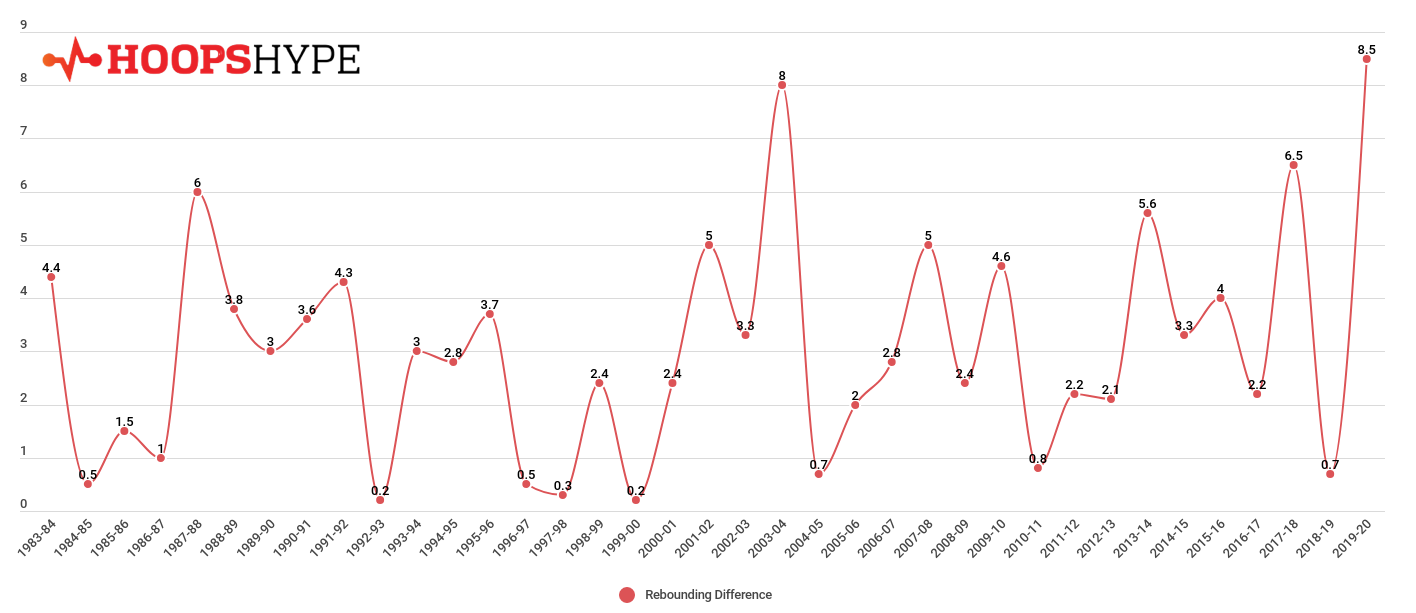The Los Angeles Lakers have used their size advantage over the Miami Heat to create plenty of mismatch opportunities in the NBA Finals.
Anthony Davis stands at 6-foot-10 with a 7-foot-6 wingspan while Dwight Howard checks in at 6-foot-11 and a 7-foot-5 wingspan. Both players are significantly taller than their opponents considering that Miami utilizes an undersized lineup with Bam Adebayo (6-foot-9) and Jae Crowder (6-foot-6) in the frontcourt.
The Lakers are simply much bigger than their opponents. This has manifested itself in several ways but is most apparent in the rebounding battle between the two teams.
Rebounding is one of the Four Factors of Basketball Success from sports analytics statistician Dean Oliver (via Basketball on Paper):
“If a team can get back its missed shots, it can partially make up for a problem with that first factor. It still eventually has to put the ball in the basket, but giving itself multiple opportunities allows a team a chance when its gunners from the outside are misfiring.”
Los Angeles recorded the sixth-best overall offensive rebound percentage (28.3 percent) among all teams in the regular season, which played a big role in helping them secure the best record in the Western Conference.
This has been even more apparent during the NBA Finals, where the Lakers (32.1 percent) rate has been considerably higher than the Heat (17.2 percent) thus far. This has certainly given them one of their most drastic competitive advantages against their Eastern Conference foes.
Miami’s Jimmy Butler has called the offensive rebounds from Los Angeles a “back-breaker” because it has led to so many second-chance opportunities.
During the championship series, Los Angeles has grabbed 45.8 rebounds per game while Miami has pulled down just 37.3 rebounds per game. This yields a total difference of 8.5 rebounds, the largest distance between two teams in this mark during the NBA Finals since 1984, per our research.
This ranks ahead of the Detroit Pistons, who were able to outrebound their championship opponents by 8.0 rebounds per game in 2004. But even that was an anomaly as, over the past 37 seasons, this is just the second time that a team has outrebounded their title opponents by more than 6.5 rebounds per game.
In fact, during this span, the average difference in boards between two teams in the NBA Finals is 3.1 rebounds per game. The figure by the Lakers is 2.75 times more than the average difference.

This figure remains consistent with what the Lakers recorded (45.7) during the regular season. But the number is quite a bit lower for the Heat (44.4) in 2019-20.
That makes sense considering Los Angeles allowed just 42.3 rebounds per game during the regular season, which finished as the best mark among all teams in the Western Conference.
LeBron James leads all players with the most rebounds (11.0) in the series, which is remarkable output from a non-big. Davis has managed to pull down 9.3 rebounds per game during the NBA Finals. Rajon Rondo, who is 6-foot-1, has grabbed as many boards per game (5.5) as big man Adebayo.
Meyers Leonard, who is 7-foot-1, has been limited to just 0.5 rebounds per game. His rebounding percentage (2.8 percent) in the series is significantly lower than his career average (13.3 percent) as well.
All things considered, the Lakers are one of the most elite rebounding teams and that has been incredibly clear against the Heat. It may even force other franchises to reshape their rosters so this does not happen to them next year.
HoopsHype’s Alberto de Roa contributed research to this report.
——————-
















